#protein rich snacks for diabetics
Explore tagged Tumblr posts
Text
Plant-Based Diets for Diabetes: For blood sugar control.
Plant-based diets, particularly vegetarian and vegan lifestyles, have been shown to significantly improve blood sugar control and overall health for people with diabetes. By focusing on whole, plant-based foods rich in fiber, antioxidants, and essential nutrients, these diets can enhance insulin sensitivity, lower blood sugar levels, and reduce the risk of diabetes-related complications. What…
#Anti-inflammatory diets for blood sugar stability#Benefits of fiber-rich diets for diabetic patients#Best vegetarian recipes for managing diabetes#Diabetes and gut health through plant-based foods#Diabetes-friendly meal plans#High-fiber diets for diabetes#How a vegan diet helps with Type 2 diabetes#Low-glycemic plant foods#Nutritional management of diabetes#Plant-based diet and diabetes#Plant-based eating and insulin sensitivity#Plant-based foods to lower blood sugar levels#Plant-based proteins for diabetics#Plant-based weight loss strategies for diabetics#Role of antioxidants in managing diabetes#Sustainable plant-based diets#Transitioning to a plant-based diet for diabetes management#Vegan diet for blood sugar control#Vegan snacks for blood sugar control#Vegetarian diet benefits for diabetics
1 note
·
View note
Text
Anyway yes, people who can X should be accomodating to people who can't X. People who can walk should accomodate people who can't. People who can hear should accomodate people who can't. People who can see should accomodate people who can't. And on and on. When that doesn't happen, it's a problem that deserves to be talked about.
But the problem is not and has never been "physical disabilities are more important and deserve more accomodations than mental disabilities"- nor the other way around either.
People love to dunk on folks with ADD/ADHD but you know? As someone with ADD raised by diabetic parents I gotta say there's a lot of similarities here. People with ADD, myself included, often forget to eat and when they do eat they often load themselves up with carbs and sugars because those foods make their brains feel good. People with diabetes have to closely monitor their meals and often crave sugars and need a blend of sugary and protein-rich snacks on hand. This is not to say ADD and diabetes are exact one-to-one disabilities.
But having grown up watching my parents manage their diabetes, I too am very aware of meal times and blood sugar and constructing meals that will tide you over and having a blend of sugary and protein-rich snacks on hand Just In Case. I am able to manage my ADD better in this way because I have experience from watching my parents. I also need access to snacks and to be able to say to my boss "I need to go eat something real fast" without being punished.
I had a training client who was the image of "able bodied mentally ill" outside of the usual creaks and squeaks associated with age, her body worked just fine. But after a series of incidents in her youth- a car accident that left her with a serious brain injury, coming home from the hospital afterwards to immediately have her house broken into and herself raped by an intruder, and assorted medical malpractice while she was healing from both- she has a serious and extreme case of agoraphobia and spent the next 40 years completely unable to leave the house. She would hide and wail and scream when deliveries of groceries and other goods would come, because it meant a stranger (and usually a man) would be at her door. She could not go more than a couple steps outside to get her mail and especially not if other people were outside.
At some point her therapist suggested getting a pet, one that *had* to go outside, to help her. So she got a dog and contacted a trainer (me) and we got to work. And she did improve! The dog has been a huge help to managing her symptoms! But you cannot seriously expect me to have worked with this woman for years and then belittle mental illnesses as being lesser when this woman also shares the inability to even leave her house let alone go inside a grocery store. Even today there are times when she simply cannot, she cannot will her body to move out of her door and into transportation let alone into the building.
When she first started coming to me she thanked me for not belittling her or making her feel bad for classes she had to cancel because she couldn't force herself to take the first step over the threshold. That is when she told me what happened to her and that while it sounds terrible she was really happy to have found a trainer who knew something personal about trauma and brain injuries. She is also a case where I feel her ESA should be considered service dog not because of training or tasking but because her need is so high and she is just completely incapable of doing anything without the dog in her arms.
Anyway I think of her any time someone says "but you can walk through the door". There's nothing wrong with her legs so in theory sure she could. But often she *can't*, not because of anything physical, but because she is very severely mentally ill.
4K notes
·
View notes
Text
Recipe tutorials
Quick meals
Healthy recipes
Vegan cooking
Vegetarian dishes
Meal planning
Budget meals
Family dinners
Breakfast ideas
Lunch recipes
Dinner options
Snacks
Appetizers
Soups
Salads
Desserts
Baking basics
Bread making
Pasta dishes
Seafood recipes
Meat meals
Poultry recipes
Barbecue tips
Grilling techniques
Slow cooker recipes
Instant Pot meals
Food prep hacks
Cooking tips
Chef secrets
Culinary skills
Knife skills
Food safety
Gluten-free
Keto recipes
Paleo diet
Low-carb options
Dairy-free
Nut-free cooking
Sugar-free desserts
Comfort food
Gourmet dishes
International cuisine
Asian recipes
Italian cooking
Mexican dishes
French cuisine
Indian recipes
Middle Eastern food
Vegan desserts
Vegetarian breakfast
Festive meals
Thanksgiving recipes
Christmas dinner
Easter treats
Halloween snacks
Valentine’s Day dishes
Cooking shows
Food challenges
Kitchen gadgets
Cookware reviews
Ingredient guides
Spices and herbs
Organic ingredients
Farm-to-table
Sustainable eating
Leftovers ideas
Kids' meals
Baby food
Cooking for seniors
Student recipes
Batch cooking
One-pot meals
Charcuterie boards
Cheese pairing
Wine pairing
Cocktail recipes
Smoothies
Juices
Coffee concoctions
Tea recipes
Plant-based nutrition
Superfoods
Anti-inflammatory meals
Probiotic-rich foods
High-protein snacks
Energy-boosting meals
Low-calorie snacks
Heart-healthy diets
Diabetic-friendly meals
Allergy-aware cooking
Culinary trends
Food vlogging
Cooking classes online
Food photography tips
Food festival tours
Culinary competitions
Chef interviews
Seasonal ingredients
Food market tours
Culinary travel adventures
#lifestyle#food#dinner#Dinner ideas#Easy dinner ideas#Dinner recipes#Dinner ideas healthy#Healthy dinner ideas#Quick dinner ideas#Easy dinner recipes for family#Easy dinner ideas for family#Dinner ideas for two#Easy dinner ideas healthy#Dinner ideas for tonight#Easy dinner ideas for two#Dinner ideas for two easy#Dinner ideas vegetarian#Quick and easy meals#Dinner ideas easy#Quick dinner ideas for 2#Easy weeknight dinners for family#Dinner ideas for two healthy#Dinner menu#Recipe tutorials#Quick meals#Healthy recipes#Vegan cooking#Vegetarian dishes#Meal planning#Budget meals
94 notes
·
View notes
Text






Life plods on, no matter how we react to it. It carries on, independent of how we allow it to affect us, and whatever it throws at us.
So we need to try make that time feel more like a blessing than a chore.
With all it's twists and turns. All it's ups and downs. All it's gifts and challenges.
Going on from something I was talking about yesterday, I'm going to stop worrying about sticking to particular fast times.
I've reset my timer for the "flexi" approach. No set time.
Whether I get to 16hrs, 14hrs, 12hrs, etc. That's now going to be dictated by how I feel from each evening to when I have my first meal the following morning.
No more stressing. No more need to set a time and feel I have to stick to it no matter what. And if I want a late snack, so be it.
I have given myself an active morning. And protein and fat rich nutrition.
I stopped counting calories and macros a little while ago, because I know what I'm focusing on, and my weight has remained stable.
Forget the menopausal nonsense I'm going through. Forget my trouble trying to stabilise my rebellious diabetes treatment tech.
Forget the stupid inflammatory symptoms that refuse to lay down and die.
I'm doing my best every single day, and I'm actually doing pretty good!
#fitspo#fitspiration#fitblr#healthy living#fitness#health and fitness#fit#suzieb-fit#health and nutrition#diet and nutrition#healthy nutrition
7 notes
·
View notes
Text
The Role of Protein-Rich Foods in Semaglutide-Fueled Weight Loss
Semaglutide, a medication originally developed for managing Type 2 diabetes, has gained significant attention for its weight loss benefits. However, to maximize its effectiveness, a supportive diet is essential. Protein-rich foods play a crucial role in enhancing the weight loss effects of Semaglutide, making them an indispensable part of your dietary plan. In this article, we’ll explore why protein matters, how it complements Semaglutide, and highlight the best foods to eat on Semaglutide for sustainable weight loss.
Why Protein Matters for Weight Loss

Protein is a vital macronutrient that supports multiple bodily functions, especially during weight loss. Its benefits include:
1. Increased Satiety
Protein helps you feel fuller for longer by reducing the hunger hormone ghrelin and increasing appetite-regulating hormones like GLP-1, the same hormone targeted by Semaglutide. Combining protein with Semaglutide enhances feelings of fullness and minimizes overeating.
2. Muscle Preservation
When losing weight, the body can lose muscle mass along with fat. Protein helps preserve lean muscle, ensuring that the majority of weight lost comes from fat. This is crucial for maintaining a healthy metabolism.
3. Boosted Metabolism
Digesting protein requires more energy than digesting fats or carbohydrates, a phenomenon known as the thermic effect of food (TEF). Including protein-rich foods in your Semaglutide-fueled diet can give your metabolism a slight boost.
How Protein-Rich Foods Complement Semaglutide
Semaglutide works by mimicking GLP-1, a hormone that regulates appetite and blood sugar levels. Protein-rich foods enhance this effect by naturally stimulating GLP-1 secretion. This synergy leads to:
Enhanced appetite control
Improved blood sugar stability
Better adherence to calorie-controlled diets
When combined with a high-protein diet, Semaglutide can deliver faster and more sustainable weight loss results.
Best Protein-Rich Foods to Eat on Semaglutide

To ensure your diet aligns with Semaglutide’s benefits, focus on these protein-rich options:
1. Lean Meats
Chicken Breast: Low in fat and high in protein, chicken breast is an excellent choice for weight loss.
Turkey: Another lean meat option that’s rich in protein and low in calories.
2. Fish and Seafood
Salmon: Packed with protein and omega-3 fatty acids, salmon promotes heart health while keeping you full.
Tuna: A convenient, protein-dense food that’s perfect for quick meals or snacks.
Shrimp: Low-calorie and high in protein, shrimp is an ideal addition to a weight loss diet.
3. Eggs
Eggs are versatile, nutrient-rich, and an affordable source of high-quality protein. They’re perfect for breakfast, snacks, or as a meal component.
4. Dairy Products
Greek Yogurt: High in protein and probiotics, Greek yogurt supports digestion and satiety.
Cottage Cheese: A low-fat, protein-packed dairy option that’s easy to incorporate into meals.
5. Plant-Based Proteins
Legumes: Lentils, chickpeas, and black beans are rich in protein and fiber, making them a filling and nutritious choice.
Tofu and Tempeh: Excellent options for vegetarians and vegans, these soy-based proteins are versatile and nutrient-dense.
Quinoa: A complete protein that’s also gluten-free and rich in fiber.
6. Nuts and Seeds
While calorie-dense, nuts and seeds like almonds, chia seeds, and flaxseeds provide plant-based protein, healthy fats, and fiber. Consume them in moderation.
How to Incorporate Protein-Rich Foods Into Your Diet

1. Prioritize Protein at Every Meal
Ensure that each meal contains a significant protein source to maintain satiety and support muscle preservation.
2. Snack Smart
Choose protein-rich snacks like boiled eggs, Greek yogurt, or a handful of nuts to curb hunger between meals.
3. Combine Protein With Fiber
Pair protein with fiber-rich foods like vegetables or whole grains to enhance satiety and support digestion.
4. Plan and Prep Meals
Prepping meals with a focus on protein ensures you stay consistent with your dietary goals while on Semaglutide.
Foods to Limit or Avoid
While protein-rich foods are beneficial, it’s essential to avoid processed and high-fat protein sources, such as:
Fried meats
Processed deli meats (e.g., sausages, hot dogs)
Full-fat dairy products
Instead, opt for lean, minimally processed options to maximize weight loss benefits.
Breaking Through Weight Loss Plateaus on Semaglutide
Even with Semaglutide, weight loss plateaus can occur. Increasing protein intake is one strategy to break through a plateau. Other tips include:
Adjusting Calorie Intake: Reassess your calorie needs as your weight decreases.
Increasing Physical Activity: Incorporate resistance training to build muscle and boost metabolism.
Hydration and Sleep: Staying hydrated and getting enough sleep are essential for weight loss success.
Conclusion
Protein-rich foods play a pivotal role in enhancing the weight loss effects of Semaglutide. By prioritizing lean proteins, incorporating plant-based options, and avoiding processed choices, you can maximize the medication’s benefits and achieve sustainable results.
Discover the best foods to eat on Semaglutide and make protein a cornerstone of your dietary plan for a healthier, more successful weight loss journey!
2 notes
·
View notes
Text
Ultimate Guide to the Best Keto Diet Food List: Top Foods to Stay in Ketosis

The ketogenic diet, commonly known as the keto diet, has gained immense popularity for its potential to help with weight loss, improved energy levels, and overall health. At the core of this diet is a high-fat, low-carb approach that shifts the body into a state of ketosis. To succeed on this diet, it’s essential to know which foods are best suited for it. In this article, we'll provide you with the best keto diet food list that will help you stay on track and achieve your goals.
Think you know the keto diet? Test your knowledge with our interactive quiz! 🧠💪 Find out how much you really know. Take the quiz now.
What is the Keto Diet?

Before diving into the best keto diet food list, let’s briefly understand what the keto diet is. The keto diet involves drastically reducing your carbohydrate intake and replacing it with fat. This reduction in carbs puts your body into a metabolic state called ketosis, where fat, instead of carbohydrates, becomes the primary fuel source.
Benefits of the Keto Diet
The keto diet offers several benefits:
Weight Loss: By cutting down carbs, the body burns fat for energy.
Improved Mental Focus: The brain uses ketones, which are produced during ketosis, as a fuel source, leading to better mental clarity.
Stable Blood Sugar Levels: The keto diet can help manage blood sugar levels, which is beneficial for people with diabetes.
Best Keto Diet Food List
When following a keto diet, choosing the right foods is crucial. Here’s the best keto diet food list to help you stay in ketosis and enjoy a variety of delicious meals.
1. Healthy Fats and Oils

Healthy fats are the cornerstone of the keto diet. Here are some of the best sources:
Avocado Oil: Great for cooking due to its high smoke point.
Olive Oil: Perfect for salads and low-heat cooking.
Coconut Oil: Rich in medium-chain triglycerides (MCTs) that support ketosis.
Butter and Ghee: Ideal for cooking and adding flavor to dishes.
Nuts and Seeds: Almonds, chia seeds, and flaxseeds are excellent sources of healthy fats.
2. Low-Carb Vegetables
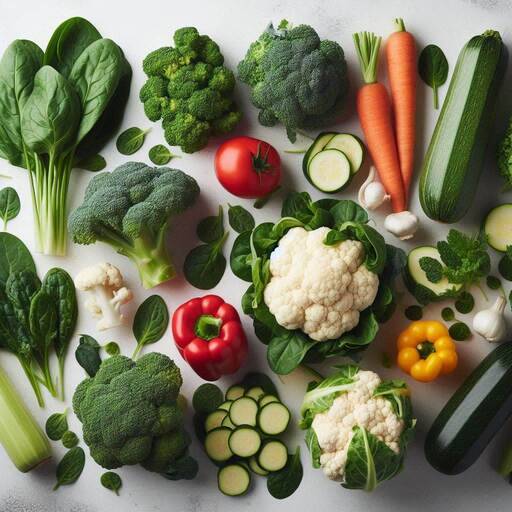
Vegetables are an essential part of the best keto diet food list as they provide fiber, vitamins, and minerals with minimal carbs:
Leafy Greens: Spinach, kale, and arugula are low in carbs and high in nutrients.
Cruciferous Vegetables: Broccoli, cauliflower, and Brussels sprouts are great for keto-friendly dishes.
Zucchini: A versatile vegetable that can be used in place of pasta or as a side dish.
Bell Peppers: Low in carbs and rich in vitamins, making them a tasty addition to any meal.
Mushrooms: Low in carbs and add a meaty texture to dishes.
3. Protein Sources
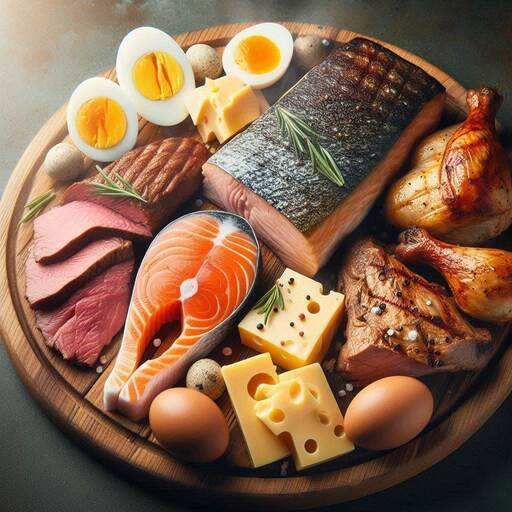
While the keto diet is high in fat, it also includes moderate amounts of protein. Here are some top protein options:
Fatty Fish: Salmon, mackerel, and sardines are rich in omega-3 fatty acids and perfect for the keto diet.
Meat: Grass-fed beef, pork, and lamb provide essential nutrients and are keto-friendly.
Poultry: Chicken thighs and turkey are great for adding variety to your meals.
Eggs: A versatile protein source that can be used in various keto recipes.
Cheese: Hard cheeses like cheddar and parmesan are low in carbs and high in fat.
Think you know the keto diet? Test your knowledge with our interactive quiz! 🧠💪 Find out how much you really know. Take the quiz now.
4. Dairy Products
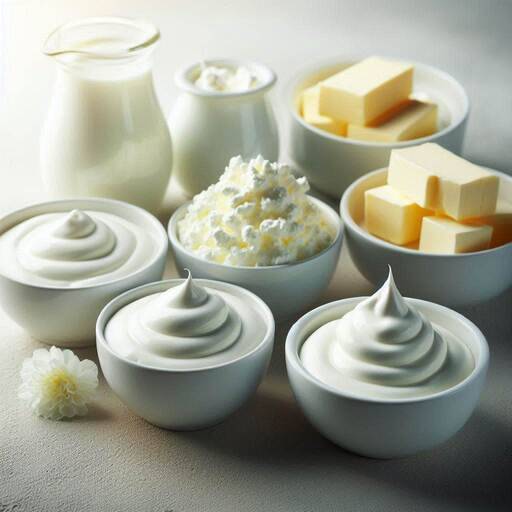
Dairy products are another key component of the best keto diet food list, providing both fat and protein:
Heavy Cream: Use it in coffee or keto-friendly desserts.
Full-Fat Yogurt: Choose unsweetened versions to avoid extra carbs.
Cream Cheese: A delicious addition to snacks and meals.
Sour Cream: Perfect for adding richness to your dishes.
Butter: A staple in keto cooking, ideal for sautéing and baking.
5. Nuts and Seeds

Nuts and seeds are excellent snacks that are high in healthy fats and low in carbs:
Almonds: A great source of vitamin E and magnesium.
Walnuts: Rich in omega-3 fatty acids, perfect for keto.
Chia Seeds: High in fiber and can be used in puddings and smoothies.
Flaxseeds: Excellent for adding to keto-friendly bread and baked goods.
Pumpkin Seeds: A crunchy snack with healthy fats and protein.
6. Berries

While most fruits are high in sugar and carbs, some berries can fit into a keto diet:
Strawberries: Low in carbs and can be enjoyed in moderation.
Raspberries: High in fiber and low in sugar.
Blackberries: Another low-carb berry option for keto dieters.
Blueberries: Best consumed in small quantities due to their higher carb content.
7. Beverages

Staying hydrated is crucial, and there are several keto-friendly drink options:
Water: The best choice for staying hydrated.
Herbal Teas: Unsweetened teas like green tea or chamomile are keto-friendly.
Coffee: Black coffee or with added heavy cream is ideal for the keto diet.
Bone Broth: Provides electrolytes and is perfect for those on a keto diet.
Sparkling Water: Choose unsweetened versions for a refreshing drink.
8. Snacks

The keto diet doesn’t mean you have to give up snacking. Here are some keto-friendly snacks:
Pork Rinds: A crunchy, low-carb snack.
Cheese Crisps: Made from baked cheese, these are a perfect keto snack.
Hard-Boiled Eggs: Simple and nutritious.
Olives: High in healthy fats and low in carbs.
Keto Bars: Low-carb bars specifically made for keto dieters.
Tips for Following the Best Keto Diet Food List

To make the most out of the best keto diet food list, here are some tips:
Meal Prep: Plan and prepare your meals in advance to stay on track.
Read Labels: Always check for hidden carbs and sugars in packaged foods.
Stay Hydrated: Drink plenty of water to support your body during ketosis.
Monitor Macros: Keep track of your fat, protein, and carb intake to ensure you stay within your keto goals.
Think you know the keto diet? Test your knowledge with our interactive quiz! 🧠💪 Find out how much you really know. Take the quiz now.
Conclusion
The best keto diet food list is packed with delicious and nutritious options that will help you succeed on your keto journey. By focusing on healthy fats, low-carb vegetables, quality proteins, and keto-friendly snacks, you can enjoy a variety of meals while staying in ketosis. Remember to plan your meals, stay hydrated, and always read labels to ensure you're sticking to your keto goals.
The ketogenic diet is not just a fad; it's a lifestyle change that can offer numerous health benefits. With the right foods, you can achieve your desired results and maintain them over time.
2 notes
·
View notes
Text
Why You Should Buy Vegan Food: A Look at Vezlay Foods
Introduction
Have you ever thought about going vegan? Maybe you've heard about the health benefits or the positive impact on the environment. But how do you start, and where do you find the right products? In this article, we're diving into the world of vegan food, focusing on a key player in the industry, Vezlay Foods. Whether you're a seasoned vegan or just curious, you'll find valuable insights here. And if you're looking to Buy Vegan Food, Vezlay Foods is a great place to start.
The Rise of Vegan Food
Veganism isn't just a trend; it's a movement. It has its roots in ancient cultures, but it's grown massively in recent years. From a niche lifestyle to mainstream adoption, veganism is now endorsed by celebrities, influencers, and athletes alike. With increasing awareness of health and environmental issues, more people are choosing to buy vegan food and embrace this lifestyle.
Health Benefits of Buy Vegan Food
Switching to a vegan diet can do wonders for your health. It's packed with nutrients like fiber, vitamins, and antioxidants. Studies have shown that a plant-based diet can reduce the risk of chronic diseases such as heart disease, diabetes, and certain cancers. Additionally, vegan food can boost your mood and mental health, thanks to its rich nutrient profile.
Environmental Impact of Veganism
Choosing vegan food isn't just good for you; it's good for the planet. The production of plant-based foods generates a lower carbon footprint compared to animal products. It also conserves water and land resources. Plus, by opting to buy vegan food, you're supporting animal welfare and reducing the demand for factory farming.
Challenges of Maintaining a Vegan Diet
While the benefits are clear, maintaining a vegan diet can come with challenges. There are misconceptions that vegan diets lack essential nutrients like protein and B12. However, with proper planning and a variety of foods, these concerns can be easily managed. Social and cultural factors can also pose challenges, but the growing availability of vegan options is making it easier.
Introduction to Vezlay Foods
Enter Vezlay Foods, a company dedicated to making veganism accessible and delicious. Founded with a mission to provide healthy and sustainable food options, Vezlay offers a wide range of vegan products. Their innovative approach and commitment to quality have made them a favorite among vegans and non-vegans alike.

Popular Products by Vezlay Foods
Vezlay Foods has an impressive lineup of products. From vegan meats like soy-based chicken and mutton to ready-to-eat meals and snacks, they've got something for everyone. Their products are designed to mimic the taste and texture of traditional meat, making the transition to veganism seamless.
Nutritional Value of Vezlay Products
What sets Vezlay Foods apart is their focus on nutrition. Their products are made with high-quality ingredients that offer substantial health benefits. For instance, their vegan meats are rich in protein and low in fat. Compared to traditional meat products, Vezlay Foods' offerings are a healthier and more ethical choice.
Cooking with Vezlay Foods
If you're new to vegan cooking, Vezlay Foods makes it easy. Their products come with simple recipes and cooking tips. Whether you're making a quick stir-fry or planning a gourmet meal, Vezlay's vegan options can be a game-changer. Try incorporating their products into your weekly meal plan for delicious and nutritious meals.
Buy Vegan Food
Wondering where to buy vegan food? Vezlay Foods' products are available in many health food stores and online. Shopping online can be particularly convenient, offering a broader range of products and often at competitive prices. Look for budget-friendly options and stock up on your favorites.
Customer Reviews and Testimonials
Don't just take our word for it; check out what customers are saying. Many users have shared their positive experiences with Vezlay Foods, praising the taste, convenience, and health benefits. Success stories highlight how Vezlay products have helped people transition to a vegan diet and improve their overall well-being.
Veganism in Different Cultures
Veganism isn't limited to one region; it's a global phenomenon. Different cultures have their own traditional vegan dishes, from Indian curries to Mediterranean salads. Vezlay Foods takes inspiration from these diverse culinary traditions, offering products that cater to various tastes and preferences.
Vegan Food and Fitness
Athletes and fitness enthusiasts are increasingly turning to vegan diets for optimal performance. Vegan food provides ample protein and other nutrients essential for muscle recovery and energy. Vezlay Foods offers products perfect for pre and post-workout meals, ensuring you get the nutrition you need to stay active.
Future of Vegan Food
The future of vegan food looks promising, with continuous innovations and growing popularity. Vezlay Foods is at the forefront, constantly developing new products to meet the demands of health-conscious consumers. Keep an eye on upcoming trends and new releases from Vezlay as they continue to lead the way in vegan food innovation.
Conclusion
Vegan food is more than just a diet; it's a lifestyle that benefits your health, the environment, and animal welfare. Vezlay Foods plays a significant role in promoting veganism by providing delicious, nutritious, and sustainable products. So why not give Vezlay a try and start your journey towards a healthier and more compassionate lifestyle? Remember, when you buy vegan food from Vezlay, you're making a positive choice for yourself and the planet.
2 notes
·
View notes
Text

The Power of Fiber: Fueling Your Health and Fitness Journey
While often overlooked, fiber plays a crucial role in maintaining a healthy diet and achieving your fitness goals. Fiber is a type of carbohydrate that cannot be digested by the body. Instead, it passes through the digestive system relatively intact, offering a range of health benefits. Incorporating fiber into your diet can:
1. Promote Healthy Digestion: Fiber adds bulk to your stool, aiding regular bowel movements and preventing constipation. It also supports a healthy gut microbiome, promoting optimal digestion and nutrient absorption.
2. Keep You Feeling Full: High-fiber foods take longer to digest, keeping you satiated for longer periods. This can help control appetite, reduce overeating, and support weight management goals.
3. Regulate Blood Sugar Levels: Soluble fiber, found in certain foods, can slow down the absorption of glucose, preventing blood sugar spikes. This is particularly beneficial for individuals with diabetes or those aiming to maintain stable energy levels throughout the day.
4. Support Heart Health: Studies show that a high-fiber diet can lower cholesterol levels, reducing the risk of heart disease and promoting overall cardiovascular health.
Fiber-Rich Foods:
1. Whole Grains: Opt for whole wheat bread, brown rice, quinoa, oats, and whole wheat pasta. These provide more fiber and nutrients compared to their refined counterparts.
2. Legumes: Incorporate beans, lentils, chickpeas, and split peas into your recipes. They are not only rich in fiber but also offer plant-based protein.
3. Fruits: Enjoy the natural sweetness and fiber content of apples, pears, berries, oranges, and bananas. Remember to consume them with the skin whenever possible to maximize fiber intake.
4. Vegetables: Load up on fiber by including broccoli, Brussels sprouts, carrots, spinach, kale, and sweet potatoes in your meals. These veggies offer an array of vitamins and minerals too!
5. Nuts and Seeds: Snack on almonds, chia seeds, flaxseeds, and pumpkin seeds. They provide healthy fats, protein, and a good dose of fiber.
From promoting healthy digestion to managing weight and reducing the risk of chronic diseases, fiber plays a vital role in overall wellness. So, make sure to include fiber-rich foods in your meals and enjoy the numerous nutritional benefits they offer. Stay fit, stay healthy!
#fitblr#informational#food#health#fitness#healthy#healthy food#nutrition#healthyfood#healthy eating#healthy living#nutrients#fitblrs#running#fiber#solublefiber#insoluble fiber#my post#personal#personal fitblr#fitfam#fitspo#fitspiration#goal setting#lifestyle#life tips#nutritional#healthy diet#healthy habits
8 notes
·
View notes
Text
The Ultimate Guide to Losing Belly Fat: Strategies for a Trim and Toned Midsection

Dreaming of a flat and toned stomach? You're not alone. Belly fat is a common concern for many people, but with the right approach, you can achieve your goals and reveal those sculpted abs. In this comprehensive guide, we'll explore the best strategies for losing belly fat, including the use of belly fat burners, effective dietary and exercise practices, and lifestyle adjustments to support your journey to a slimmer midsection.
Understanding Belly Fat
Before diving into the strategies for losing belly fat, it's essential to understand the different types of fat and why belly fat can be particularly stubborn. There are two main types of belly fat:
Subcutaneous Fat: This type of fat lies just beneath the skin and is often referred to as "pinchable" fat. While subcutaneous fat can contribute to a protruding belly, it is less harmful to health compared to visceral fat.
Visceral Fat: Located deep within the abdominal cavity, visceral fat surrounds vital organs such as the liver, pancreas, and intestines. Excess visceral fat is associated with an increased risk of various health conditions, including heart disease, type 2 diabetes, and certain cancers.
Best Strategies for Losing Belly Fat

1. Incorporate Cardiovascular Exercise:
Cardiovascular exercise, such as running, cycling, swimming, or brisk walking, can help burn calories and reduce overall body fat, including belly fat. Aim for at least 150 minutes of moderate-intensity cardio or 75 minutes of vigorous-intensity cardio per week, supplemented with strength training exercises to build lean muscle mass.
2. Focus on High-Intensity Interval Training (HIIT):
HIIT workouts involve alternating between short bursts of high-intensity exercise and periods of rest or low-intensity activity. HIIT has been shown to be particularly effective for reducing abdominal fat and improving overall fitness levels in a shorter amount of time compared to traditional steady-state cardio.
3. Incorporate Strength Training:
Strength training exercises, such as squats, lunges, deadlifts, and planks, can help build lean muscle mass and boost metabolism, leading to increased calorie burning and fat loss. Aim to include strength training workouts targeting the major muscle groups at least two to three times per week.
4. Adopt a Balanced Diet:
Focus on consuming a balanced diet rich in whole, nutrient-dense foods such as fruits, vegetables, lean proteins, whole grains, and healthy fats. Minimize intake of processed foods, sugary snacks, and refined carbohydrates, which can contribute to belly fat accumulation and overall weight gain.
5. Monitor Portion Sizes:
Practice portion control to avoid overeating and excess calorie consumption, which can lead to weight gain and belly fat accumulation. Use smaller plates, measure serving sizes, and pay attention to hunger and fullness cues to help regulate food intake.
The Role of Belly Fat Burners
Belly fat burners are supplements or compounds designed to enhance fat burning, particularly in the abdominal region. These products often contain ingredients such as caffeine, green tea extract, and forskolin, which are believed to increase metabolism, promote fat oxidation, and support weight loss. While belly fat burners may offer some benefits, they are not a magic solution for losing belly fat and should be used in conjunction with a balanced diet and regular exercise for best results.
Lifestyle Adjustments for Belly Fat Loss
In addition to diet and exercise, making lifestyle adjustments can help support your efforts to lose belly fat:
Get Adequate Sleep: Aim for seven to nine hours of quality sleep per night to support hormone balance, metabolism, and overall health.
Manage Stress: Chronic stress can lead to increased cortisol levels, which may contribute to belly fat accumulation. Practice stress-reducing techniques such as meditation, deep breathing exercises, or spending time in nature.
Stay Hydrated: Drink plenty of water throughout the day to stay hydrated and support digestion, metabolism, and overall health.
Conclusion
Losing belly fat requires a multifaceted approach that includes regular exercise, a balanced diet, lifestyle adjustments, and potentially the use of belly fat burner supplements. By incorporating cardiovascular exercise, strength training, and HIIT workouts into your routine, adopting a balanced diet rich in whole foods, and making lifestyle adjustments to support overall health and well-being, you can achieve your goals and reveal a trim and toned midsection. Remember to be patient and consistent, as losing belly fat takes time and dedication. With the right approach and mindset, you can say goodbye to belly fat and hello to a healthier, happier you.
4 notes
·
View notes
Text
Unveiling the Health Benefits of Cashew Nuts: A Nutritional Treasure Trove
Cashew nuts, commonly referred to as "Kaju" in various regions worldwide, are renowned not only for their delightful taste but also for the plethora of health benefits they offer. With their nutrient-rich composition and potential positive impact on health, cashews have solidified their status as a versatile dietary staple. In this comprehensive analysis, with guidance from PTI Nuts And Spices, we'll explore the multifaceted advantages of incorporating Cashew Nuts into your diet.

Nutritional Profile:
Cashew nuts boast an impressive array of nutrients, contributing significantly to overall well-being. Serving as an excellent source of healthy fats, including beneficial monounsaturated and polyunsaturated fats crucial for heart health, cashews are also packed with protein, dietary fiber, vitamins, and minerals, making them a wholesome choice for snacks or meal accompaniments.
Heart Health:
Among the multitude of benefits associated with cashew nuts, their positive impact on heart health is particularly noteworthy. The presence of monounsaturated and polyunsaturated fats in cashews has been linked to lower levels of LDL (bad) cholesterol and triglycerides, along with an increase in HDL (good) cholesterol. This favorable lipid profile helps reduce the risk of heart disease and promotes overall cardiovascular well-being.
Weight Management:
Despite their calorie density, Cashew Nuts can be beneficial for weight management when consumed judiciously. Their unique blend of protein, healthy fats, and dietary fiber promotes feelings of fullness and satiety, effectively curbing cravings and preventing overeating. By incorporating cashews into your diet, you can effectively regulate appetite and progress towards weight loss or maintenance goals.
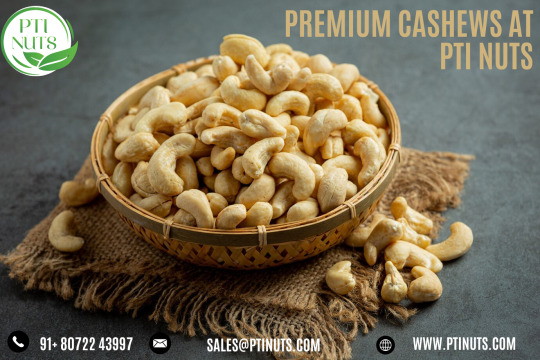
Bone Health:
Cashews emerge as champions in promoting bone health, thanks to their abundance of essential minerals such as magnesium, phosphorus, and calcium. These minerals are instrumental in bone formation, density, and overall skeletal integrity. Regular consumption of cashew nuts may significantly contribute to improved bone density and reduced susceptibility to osteoporosis and fractures, especially as individuals age.
Antioxidant Benefits:
Cashew nuts exhibit remarkable antioxidant properties, characterized by vitamins E and K, as well as minerals like copper and zinc. Antioxidants play a crucial role in neutralizing harmful free radicals within the body, thereby reducing oxidative stress and cellular damage. By combating oxidative stress, cashews have the potential to mitigate the risk of chronic diseases such as cancer, diabetes, and heart disease.
Hair and Skin Health:
The abundance of vitamins and minerals in cashew nuts, particularly copper and zinc, plays pivotal roles in maintaining healthy hair and skin. Copper aids in melanin production, responsible for hair and skin coloration, while zinc supports collagen synthesis, wound healing, and skin integrity. Incorporating cashews into your diet can contribute to stronger, shinier hair and clearer, more radiant skin.
Blood Sugar Control:
Emerging research suggests that integrating cashew nuts into a balanced diet may offer benefits for blood sugar control, particularly in individuals with or at risk of type 2 diabetes. The combination of protein, healthy fats, and dietary fiber in cashews helps regulate sugar absorption into the bloodstream, preventing spikes in blood glucose levels. This may reduce the risk of insulin resistance and promote improved glycemic control over time.
Digestive Health:
Cashews are valuable allies in promoting digestive wellness, thanks to their high fiber content. Dietary fiber adds bulk to stool, softens it, and facilitates regular bowel movements, preventing constipation and supporting overall digestive health. By incorporating cashews into your diet, you can ensure adequate fiber intake and cultivate a healthy gut microbiome.
Potential Drawbacks and Considerations:
Despite their numerous health benefits, it's essential to consume cashew nuts in moderation due to their calorie density. Excessive intake may lead to weight gain and other adverse effects. Additionally, individuals allergic to cashews or other tree nuts should exercise caution and avoid consumption to prevent allergic reactions.
Incorporating Cashew Nuts Into Your Diet:
The culinary versatility of cashew nuts offers a plethora of delicious options for integration into a nutritious diet. Whether enjoyed raw or roasted as a convenient snack, added to salads, stir-fries, or grain bowls for extra flavor and texture, or blended into creamy sauces and dressings, cashew nuts enhance the culinary experience. Cashew butter, a delightful alternative to peanut butter, provides versatility as a spread or dip.
Conclusion:
In summary, cashew nuts emerge as nutritional powerhouses, offering a wealth of health benefits beyond their delicious taste. From supporting heart health and aiding in weight management to fortifying bones and enhancing hair and skin health, cashews contribute to overall well-being. By incorporating cashew nuts into your diet in moderation, you can enjoy their exquisite flavor while reaping the diverse rewards they offer. Let PTI Nuts And Spices guide you on the journey to optimal health through the inclusion of Cashew Nuts in your diet.
2 notes
·
View notes
Text
Plant-Based Diets for Diabetes: For blood sugar control.
Plant-based diets, particularly vegetarian and vegan lifestyles, have been shown to significantly improve blood sugar control and overall health for people with diabetes. By focusing on whole, plant-based foods rich in fiber, antioxidants, and essential nutrients, these diets can enhance insulin sensitivity, lower blood sugar levels, and reduce the risk of diabetes-related complications. What…
#Anti-inflammatory diets for blood sugar stability#Benefits of fiber-rich diets for diabetic patients#Best vegetarian recipes for managing diabetes#Diabetes and gut health through plant-based foods#Diabetes-friendly meal plans#High-fiber diets for diabetes#How a vegan diet helps with Type 2 diabetes#Low-glycemic plant foods#Nutritional management of diabetes#Plant-based diet and diabetes#Plant-based eating and insulin sensitivity#Plant-based foods to lower blood sugar levels#Plant-based proteins for diabetics#Plant-based weight loss strategies for diabetics#Role of antioxidants in managing diabetes#Sustainable plant-based diets#Transitioning to a plant-based diet for diabetes management#Vegan diet for blood sugar control#Vegan snacks for blood sugar control#Vegetarian diet benefits for diabetics
0 notes
Text
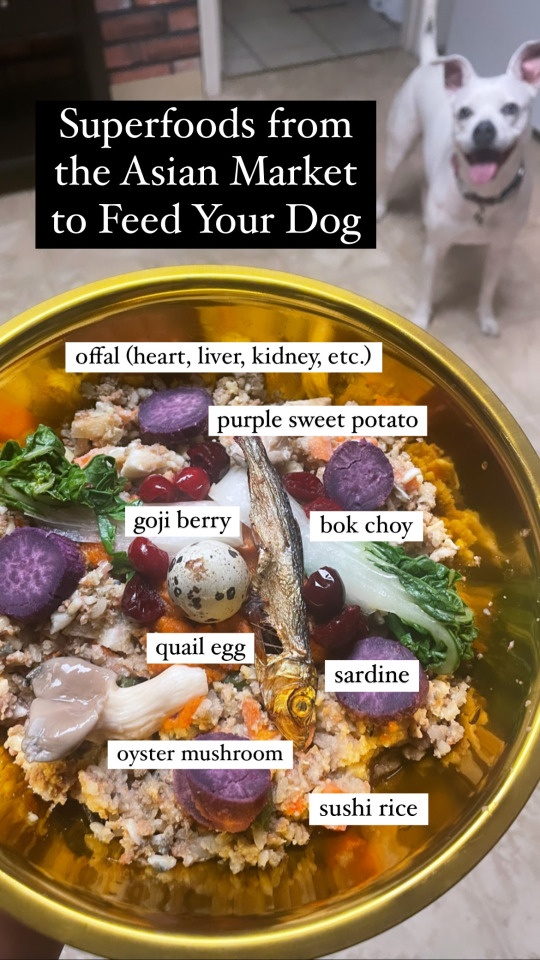
These past few years, I have become a huge advocate for feeding fresh food to dogs to enhance their lives. However, you don't exactly have to transition your dog to a 100% fresh food diet in order to gain the benefits of fresh food.
Simply adding fresh food to your dog's kibble can go a long way in improving their nutrition and overall health. For instance, one study done a group of dogs in 2005 revealed that feeding vegetables just three times a week had significantly lowered their risk of developing cancer, compared to dogs who were only fed kibble.
Asian markets, in particular, have some very beneficial fresh food items that aren't typically found at your local grocery store. These food items, however, are not intended to fully replace your dog's food. Remember - too much of something good can be bad for you.
Instead, they should be offered in moderation as treats, or just small amounts topped over an already complete and balance meal. As a general rule of thumb, treats/toppers should never make more than 10% of your dog's overall diet.
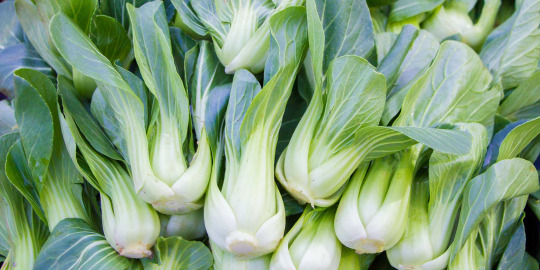
Bok choy (Chinese cabbage) is full of essential vitamins and minerals needed to support a dog’s eyesight, cardiac function, digestion, bone strength, and immunity. Sulfurophane - a compound found in bok choy and other cruciferous vegetables - has been linked to inhibiting cancer cell growth, lowering blood pressure, and activating the nuclear factor Nrf2 which prevents the development of diabetes and its complications. Bok choy’s low calorie, high fiber content also make it a good option for a snack/food topper for dogs who need to control their weight.
Preparation: Lightly steam or boil for better nutrient absorption. Cooking will also help neutralize the enzyme (myrosinase) that can decrease thyroid function. You should also chop/trim their long leaves to avoid choking hazards.
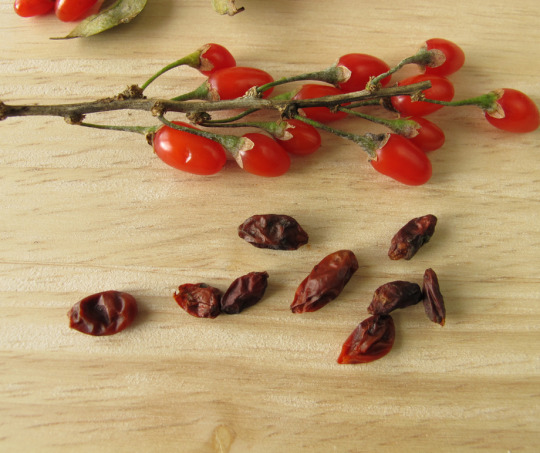
Goji berries (wolfberries) are rich in amino acids, carotenoids which support healthy vision, and polyphenols that have anti-inflammatory, anti-tumor, and cardio-protective properties. Studies on goji berry supplementation in animals have shown that it has the potential to help lower cholesterol, protect the liver by increasing hepatic antioxidant activity, as well as enhance metabolic homeostasis and prevent diabetes-induced renal inflammation.
Preparation: Remove stems if still attached and cut/mash berries. If dried, soak in water until softened to avoid passing straight through the GI tract and losing the benefits of its nutrients.
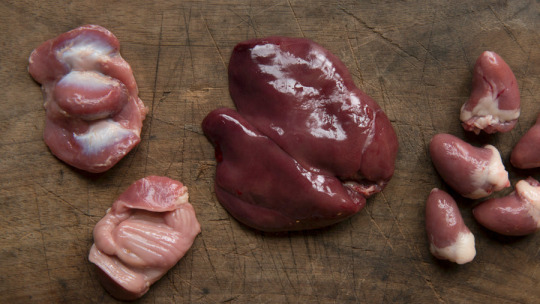
Offal refers to the internal organs and variety meats of animals that can be consumed as food (i.e. lung, heart, kidney, liver, gizzard, head, feet, etc.) The word 'offal' literally translates to "fall off", and thus, whatever falls off the skeleton during the butchering process. Offal is densely loaded with essential vitamins, minerals, proteins, and fats - so small amounts go a long way. Pet owners who use these as ingredients as part of a complete and balanced recipe should keep in mind that each organ is unique in its nutrient profile - dependent on the animal it is sourced from and how it is raised. For example, grass-fed beef may contain less fat yet more vitamin A and E than grain-fed beef, and beef liver has significantly more vitamin A and copper than chicken liver.
Preparation: Boil in water or low-sodium broth. May also be baked or dehydrated into jerky treats.
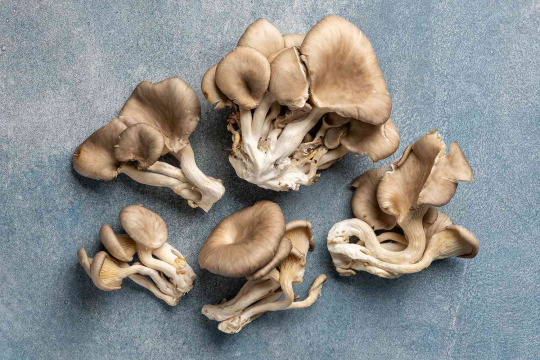
Oyster mushrooms are a good source of protein and fiber, and vitamins that support healthy digestion. They can help to increase satiety and maintain healthy body weight. Oyster mushrooms are also full of pantothenic acid which help to maintain cognitive function and healthy skin/coat. Beta-glucans derived from oyster mushrooms have also been shown to reduce inflammation and strengthen immunity.
Preparation: Lightly sauté or boil in water or low-sodium broth. Raw or dried mushrooms can be difficult for dogs to digest.
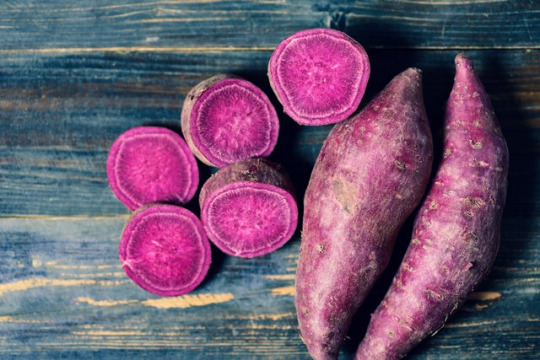
Purple sweet potato (Ube or Okinawan sweet potato) are typically found in grocery stores more commonly during the fall/winter seasons. They contain more antioxidants than regular sweet potatoes due to the anthocyanins that cause their violet hue. While all potato varieties may impact blood sugar levels because of their high carbohydrate content, purple potatoes may exert less of an effect because of their high polyphenol content that decreases the absorption of starches in the intestines. In addition, they have been linked to improving blood pressure, likely due to their high potassium content.
Preparation: Peel skin and bake until soft for better digestibility and to prevent intestinal blockages. May be boiled and drained to reduce oxalate intake for dogs with a history of bladder stones, or prone to urinary issues.
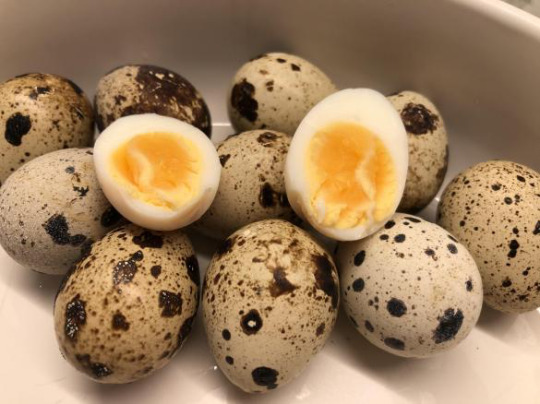
Quail eggs are small, yet packed with protein and essential fatty acids, and have a higher ratio of iron, riboflavin, and vitamin b12 than chicken eggs. It is even safe and can be beneficial to feed them with the shells included for added calcium. Quail eggs have been linked to improving bone growth/healing, reducing liver damage, and increasing energy levels. While some studies have shown evidence of quail eggs treating allergies in humans and mice, they may be less likely to trigger reactions than chicken eggs in dogs who have poultry sensitivities.
Preparation: Wash thoroughly, and handle gently as they are more fragile due to their tiny size. Cooking methods are similar to that of chicken eggs, yet require less time.
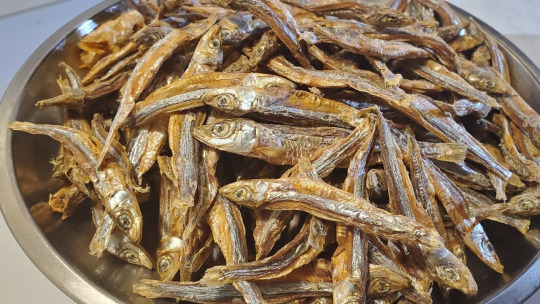
Sardines contain all the amino acids your dog needs for optimal health, making it a "complete protein". They are also notorious for being rich in omegas and coenzyme q-10, which help support heart and brain health. What sets sardines apart from other fish, too, is that they are smaller and more short-lived species than larger predator fish and may have less of a risk for mercury poisoning. Because they are so small and have soft bones, you can feed them whole to your pets.
Preparation: Bake or dehydrate. If already purchased as dried, be sure to make sure there is no added salt or seasonings. If canned, preferably those stored in water only.

Sushi rice (Japanese sticky rice) has a high proportion of starch and moisture, giving it a stickier texture when cooked. Sushi rice has virtually zero fat, yet still provides a desirable balance of nutrients while remaining gentle on a dog’s digestive tract. Its higher iron content than regular rice supports healthy blood circulation and can provide more energy to dogs who are recovering from illness. Cooling/refrigerating the rice before serving also enables more retrogradation of prebiotic fiber, helping to lower glycemic responses and maximize intestinal function.
Preparation: Rinse thoroughly and soak in water (with 1tbsp apple cider vinegar - optional) before cooking. If you don’t have a rice cooker or instant pot, boil on the stove until the water is completely absorbed. May be cooked with bone broth for added flavor. You can also use small amounts of beet root powder, turmeric, or blue spirulina to add color and nutrients.
#asian markets#pet food#dog treats#bok choy#goji berries#offal#oyster mushrooms#quail eggs#sardines#sushi rice#purple sweet potato
9 notes
·
View notes
Text
Peanuts: A nutrient-rich and versatile snack with many health benefits
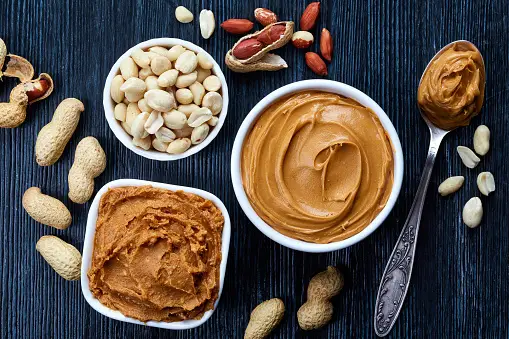
Peanuts are a type of legume that is native to South America. They are one of the most popular snack foods in the world, and for good reason. Peanuts are packed with nutrients and have been linked to a number of health benefits.
**Nutritional value of peanuts:**
Peanuts are a good source of:
* Protein: Peanuts are a good plant-based source of protein, making them a good choice for vegetarians and vegans. One ounce of peanuts contains approximately 6 grams of protein.
* Healthy fats: Peanuts contain mostly monounsaturated and polyunsaturated fats, which are good for heart health. Monounsaturated fats can help to lower LDL (bad) cholesterol levels and raise HDL (good) cholesterol levels. Polyunsaturated fats can also help to lower LDL cholesterol levels.
* Fiber: Peanuts are a good source of fiber, which can help to keep you feeling full and satisfied. Fiber can also help to improve digestion and regularity. One ounce of peanuts contains approximately 3 grams of fiber.
* Vitamins and minerals: Peanuts contain a variety of vitamins and minerals, including vitamin E, magnesium, potassium, and niacin. Vitamin E is an antioxidant that can help to protect cells from damage. Magnesium is important for muscle and nerve function. Potassium is important for blood pressure regulation. Niacin is important for energy metabolism and skin health.
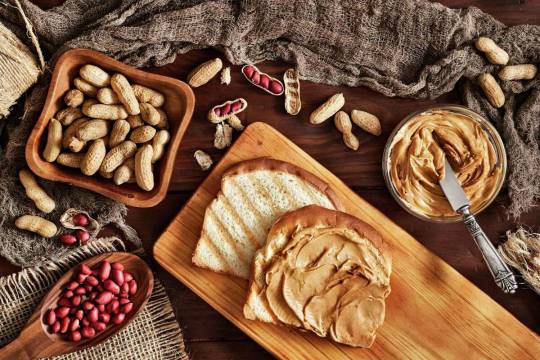
**Health benefits of peanuts:**
Peanuts have been linked to a number of health benefits, including:
* Reduced risk of heart disease: The healthy fats and antioxidants in peanuts can help to lower cholesterol levels and improve blood vessel health. A study published in the journal *Circulation* found that people who ate peanuts or peanut butter at least five times per week had a 14% lower risk of death from heart disease than those who did not eat peanuts or peanut butter.
* Improved blood sugar control: Peanuts have a low glycemic index, meaning they do not cause a rapid spike in blood sugar levels. This makes them a good snack option for people with diabetes or prediabetes. A study published in the journal *Diabetes Care* found that people with type 2 diabetes who ate peanuts or peanut butter as part of a healthy diet had lower blood sugar levels and less insulin resistance than those who did not eat peanuts or peanut butter.
* Weight management: Peanuts are high in protein and fiber, both of which can help you to feel full and satisfied. This can lead to reduced calorie intake and weight loss over time. A study published in the journal *Obesity* found that people who ate peanuts or peanut butter as part of a low-calorie diet lost more weight and body fat than those who did not eat peanuts or peanut butter.
* Cancer prevention: Some research suggests that peanuts may help to protect against certain types of cancer, such as colon cancer and breast cancer. A study published in the journal *Cancer Epidemiology, Biomarkers & Prevention* found that people who ate peanuts or peanut butter at least twice per week had a 27% lower risk of developing colon cancer than those who did not eat peanuts or peanut butter. A study published in the journal *Breast Cancer Research and Treatment* found that women who ate peanuts or peanut butter at least five times per week had a 22% lower risk of developing breast cancer than those who did not eat peanuts or peanut butter.

**How to incorporate peanuts into your diet:**
Peanuts can be eaten raw, roasted, or salted. They can also be used to make peanut butter, peanut oil, and other peanut products. Peanuts can be incorporated into a variety of dishes, including salads, soups, stews, and stir-fries.
Here are some tips for incorporating peanuts into your diet:
* Add a handful of peanuts to your breakfast cereal, oatmeal, or yogurt.
* Spread peanut butter on whole-wheat bread or crackers for a healthy snack or sandwich.
* Add peanuts to salads, soups, stews, and stir-fries.
* Snack on peanuts instead of unhealthy snacks like chips or candy.
* Make your own peanut butter at home using raw peanuts and a blender.
**Conclusion:**
Peanuts are a nutritious and versatile snack food with many health benefits. They are a good source of protein, healthy fats, fiber, and vitamins and minerals. Peanuts have been linked to a number of health benefits, including reduced risk of heart disease, improved blood sugar control, weight management, and cancer prevention. Peanuts can be easily incorporated into a variety of dishes, making them a healthy and convenient food choice for everyone.
#healthy#health#help#healthcare#headlines today news#headline news#self healing#heartbreak#healthy diet#business news#breaking news#blog#latest news#natural remedy#nutritious#world news#nature#news#money#beautiful#beauty#low cal diet#weight loss diet#life#love#long reads#liveblogging#literature#journal#gorgeous
3 notes
·
View notes
Text
Creating a Comprehensive PCOS Diet Plan for Optimal Health
Introduction to a PCOS diet plan
Polycystic Ovary Syndrome (PCOS) is a common hormonal disorder that affects many women of reproductive age. One of the most effective ways to manage PCOS and its symptoms is through a well-balanced PCOS diet plan. A PCOS diet plan can help regulate hormones, improve insulin sensitivity, and support overall health. In this article, we will delve into the essential components of a PCOS diet plan, highlighting the importance of balanced nutrition and lifestyle modifications.
Understanding PCOS
PCOS is characterized by a range of symptoms, including irregular periods, excessive hair growth (hirsutism), acne, and ovarian cysts. It is also often associated with insulin resistance and an increased risk of type 2 diabetes, heart disease, and infertility. While PCOS is a complex condition with no cure, its symptoms can be managed effectively through dietary and lifestyle changes.
Key Components of a PCOS Diet Plan
Balanced Macronutrients:
A PCOS diet plan should include a balanced distribution of macronutrients: carbohydrates, protein, and healthy fats. Aim for a well-rounded intake that includes whole grains, lean protein sources (such as tofu), and monounsaturated fats (found in olive oil, avocados, and nuts).
Complex Carbohydrates:
Choose complex carbohydrates for your PCOS diet plan like whole grains (brown rice, quinoa, oats) over simple sugars and refined grains. These complex carbs are digested more slowly, helping to stabilize blood sugar levels and reduce insulin resistance, a common issue in PCOS.
Fiber-Rich Foods:
Incorporate plenty of high-fiber foods into your PCOS diet plan, such as fruits, vegetables, legumes, and whole grains. Fiber helps regulate blood sugar and improve digestion, which can be especially beneficial for those with PCOS.
Adequate Protein:
Protein is crucial for muscle maintenance and hormone regulation. Include lean protein sources like beans in your meals to help maintain steady blood sugar levels, as part of your PCOS diet plan.
Healthy Fats:
Opt for healthy fats like avocados, nuts, seeds, and olive oil in your PCOS diet plan. These fats can help reduce inflammation and support hormone balance in the body.
Watch Your Portions in the PCOS diet plan:
Be mindful of portion sizes to avoid overeating and promote weight management. A registered dietitian can help you determine appropriate portion sizes for your specific needs. A PCOS diet plan needs it!
Take Low-Glycemic Index (GI) Foods in your PCOS diet plan:
Foods with a low GI are digested more slowly, leading to more stable blood sugar levels. Examples of low-GI foods include whole grains, legumes, non-starchy vegetables, and most fruits. These will form a part of your PCOS diet plan.
Limit Sugary Foods and Beverages:
Reduce or eliminate sugary snacks, desserts, and sweetened beverages from your PCOS diet plan. High sugar intake can exacerbate insulin resistance and lead to weight gain.
Manage Carbohydrate Intake in your PCOS diet plan:
Some individuals with PCOS may benefit from a moderate reduction in carbohydrate intake. A low-carb or ketogenic diet can be effective for weight loss and blood sugar control but should be done under the guidance of a healthcare professional.
Adequate Hydration:
Staying well-hydrated is important for overall health and can help with weight management in your PCOS diet plan. Choose water as your primary beverage and limit sugary drinks and excessive caffeine.
Lifestyle Modifications
In addition to a PCOS diet plan, lifestyle modifications can significantly impact the management of PCOS symptoms:
Regular Exercise:
Engage in regular physical activity to improve insulin sensitivity, manage weight, and reduce stress. Aim for a mix of cardiovascular exercises and strength training along with your PCOS diet plan.
Stress Reduction:
High-stress levels can exacerbate PCOS symptoms. Incorporate stress-reduction techniques like yoga, meditation, deep breathing exercises, or hobbies that bring you joy.
Adequate Sleep:
Prioritize quality sleep as it plays a crucial role in hormone regulation and overall well-being, specially with a PCOS diet plan.
Weight Management:
If overweight or obese, achieving and maintaining a healthy weight can have a positive impact on PCOS symptoms. Even a modest weight loss of 5-10% of your body weight can lead to improvements.
Medication and Supplements:
Some individuals with PCOS may require medications like birth control pills, anti-androgens, or insulin-sensitizing medications. Consult with a healthcare provider to determine if these options are appropriate for you. Additionally, certain supplements, such as inositol and chromium, may support insulin sensitivity.
Conclusion
A well-structured PCOS diet plan, combined with lifestyle modifications, can be a powerful tool in managing the symptoms of Polycystic Ovary Syndrome. It's essential to work closely with a healthcare professional or registered dietitian who can tailor a PCOS diet plan to your specific needs and monitor your progress. By focusing on balanced nutrition, regular exercise, stress reduction, and maintaining a healthy weight, you can take significant steps toward improving your overall health and well-being while managing the challenges posed by PCOS. Remember that managing PCOS is a journey, and with dedication and the right support, you can achieve positive outcomes and lead a healthier life.
3 notes
·
View notes
Text

HEALTHY ADVICE :
Eating Healthy: The Key to a Healthy Lifestyle
Leading a healthy lifestyle is important for our overall well-being, and what we eat plays a crucial role in it. A balanced diet that includes a variety of nutrient-dense foods can help us maintain our physical and mental health. In this blog, we’ll explore the importance of eating healthy and provide tips on how to make healthy eating a part of your daily routine.
Why is Eating Healthy Important?
Eating healthy foods is essential for our physical health as they provide our bodies with the essential vitamins, minerals, and nutrients it needs to function properly. A diet rich in fruits, vegetables, whole grains, and lean proteins can help reduce the risk of chronic diseases such as heart disease, type 2 diabetes, and some forms of cancer. Eating a balanced diet also helps maintain a healthy weight, improves energy levels, and strengthens the immune system.
Mental health is equally important, and the food we eat can also have a significant impact on our mental well-being. Eating a diet rich in fruits, vegetables, and whole grains can help reduce the risk of depression and improve mood and cognitive function.
How to Make Healthy Eating a Habit
Making healthy eating a part of your daily routine can be challenging, but with a little effort and planning, it can become a habit. Here are some tips to help you get started:
Plan your meals: Planning your meals in advance can help ensure you have a balanced diet and make healthy eating a habit. Start by making a grocery list of healthy foods and prepare meals at home to have more control over the ingredients and portions.
Focus on nutrient-dense foods: Fill your plate with nutrient-dense foods such as fruits, vegetables, whole grains, and lean proteins. These foods are packed with vitamins, minerals, and nutrients that are essential for good health.
Avoid processed foods: Processed foods are high in calories, unhealthy fats, and added sugars and are often low in essential nutrients. Instead, choose whole foods such as fruits, vegetables, and whole grains.
Drink plenty of water: Staying hydrated is important for our health, and drinking water can help keep us full and reduce the temptation to snack on unhealthy foods.
Practice portion control: Eating smaller portions can help control calorie intake and prevent overeating. Using smaller plates and bowls can also help with portion control.
Conclusion
Eating healthy is an important part of leading a healthy lifestyle. Focusing on nutrient-dense foods, avoiding processed foods, and practicing portion control can help make healthy eating a habit. By making healthy eating a priority, we can improve our physical and mental health and reduce the risk of chronic diseases.
#healthy eating#healthy#health & fitness#green vegetables#eating diary#it's not as simple as just eating#fruits and vegetables
10 notes
·
View notes
Text
Top 5 Weight Loss Tips To Help You Shed Pounds

Are you struggling to lose weight and keep it off? Maintaining a healthy weight is crucial for overall well-being and reducing the risk of chronic illnesses such as diabetes and heart disease. In this post, we'll share the top 5 weight loss tips to help you shed those extra pounds.
1. Eat a Balanced Diet: Fill your plate with plenty of fruits, vegetables, lean protein, healthy fats, and whole grains. Eating a balanced diet will keep you feeling satisfied for longer, making it easier to avoid unhealthy snacks.
2. Stay Hydrated: Drinking water is essential for weight loss as it boosts your metabolism and helps flush out toxins from your body. Aim to drink 8-10 glasses of water every day.

3. Exercise Regularly: Incorporating physical activity into your daily routine is essential for weight loss. Aim for at least 30 minutes of moderate-intensity exercise per day, such as brisk walking, cycling, or swimming.
4. Limit Processed Foods: Highly processed foods are typically high in calories, saturated fats, and refined sugars, making them a major contributor to weight gain. Try to limit your intake of processed foods and opt for whole, nutrient-rich foods instead.
5. Get Enough Sleep: Lack of sleep can disrupt your hormones, leading to weight gain and increased appetite. Aim for 7-9 hours of good quality sleep every night to support your weight loss efforts.

Remember, healthy and sustainable weight loss takes time, patience, and perseverance. Start small and make gradual changes to your lifestyle to see lasting results.
What weight loss tips have worked for you? Share your thoughts in the comments below!
Health is wealth that is why it is primordial we take proper care of it. I strongly recommend you click on the link below to have access to my blog where I publish on regular basis health related content like this to help you achieve your weight loss objectives or simply stay healthy with some home based tips and tricks.
#healthcare#motivation#nutrition#need to lose more weight#inspiring quotes#self discipline#self love#fitness#keep hydrated#fat belly#loseweighfast#healthy eating#tips and tricks#self care#loseweightnow#loseweightnaturally#lose weight in 30 days#Lossweightin2weeks#Loseweightin7days
2 notes
·
View notes